
Learn how easy it is to make Fresh Italian Basil Pesto or Pesto alla Genovese. With 7 ingredients and 5 minutes, you can have the simple, fresh flavors of this classic Italian recipe.

Jump to:
🇮🇹 What is Pesto alla Genovese?
Basil Pesto or Pesto alla Genovese originated in Genoa in the Liguria region in Northern Italy. Traditional Basil Pesto consists of basil, garlic, pine nuts, parmesan cheese, salt, and olive oil. Originally, pesto was made using a mortar and pestle, but nowadays, most use a food processor.
🌿 Ingredients to Make Pesto
My recipe for Homemade Basil Pesto is pretty close to the authentic genovese recipe. I add fresh lemon juice to help preserve the green color, add freshness, and cut the bitterness.
Below are the 7 ingredients you need to make this pesto, along with notes on the key ingredients.
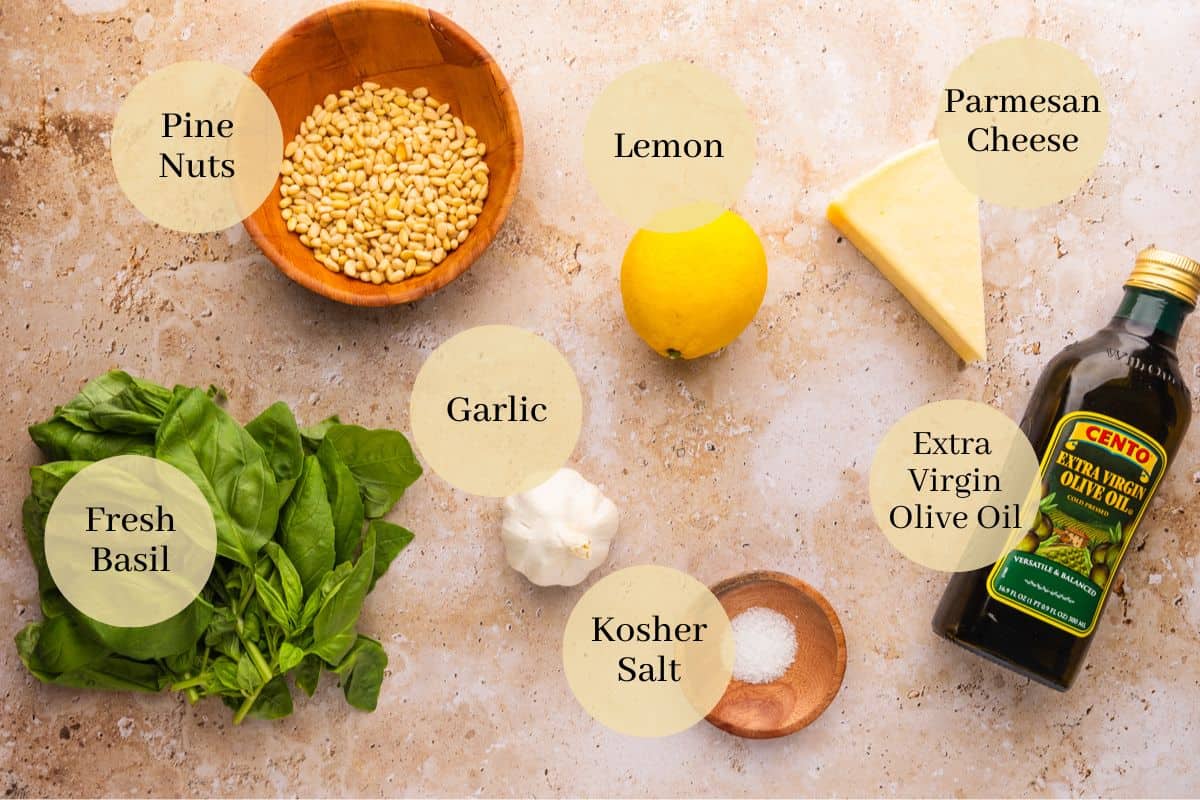
- Basil - Fresh basil is the main ingredient in pesto. I have a fresh basil plant in my kitchen that I use, however, most grocery stores sell basil plants or packages of fresh basil. Pesto is great because you can use both the leaves and the stems, so there is no waste!
- Olive Oil - I highly recommend using extra virgin olive oil. If you have a more expensive olive oil, this is the time to use it. The better, more pure and higher quality olive oils are perfect for pesto, where the simplicity will allow the flavors to shine through. Read more about Different Types of Olive Oil and how they affect flavor in recipes so you can choose the perfect one for pesto and other dishes.
- Pine Nuts - Pine nuts are the traditional nuts used in pesto. You can find them alongside other nuts in the grocery store typically in the baking aisle or bulk food section. They have a very soft, nutty flavor that pairs with the earthy, sweet basil, fruity olive oil, and sharpness of the fresh garlic and parmesan cheese.
- Parmesan Cheese - I always recommend using freshly grated cheese. It will add a more sharp and fresh flavor to the pesto instead of pre-grated cheese. If you can get your hands on authentic Parmigiano-Reggiano, then this would be the recipe to use it on. Again, like the olive oil, the higher-quality cheese is great for simple recipes where the flavors shine through. Pecorino Romano cheese is another hard Italian cheese that would be great for pesto. You can read more about these Italian Cheeses so you can make sure you can get exactly what you need.
- Garlic - Fresh garlic is a must for this recipe. It will give you a bright, fresh flavor that pre-chopped jarred garlic won't.
⭐ Chef's Secret
For an extra nutty flavor in your pesto, lightly toast them in a small skillet over medium heat on the stovetop until lightly browned.
👩🏻🍳 How to Make Italian Pesto in 5 Minutes
Add the fresh basil (both stems and leaves!) to a food processor along with the pine nuts, parmesan, olive oil, garlic, lemon juice, and salt.
Pulse the ingredients until combined, then scrape down the sides and mix for 30 seconds. (You can mix longer if you want the pesto to be smoother.)
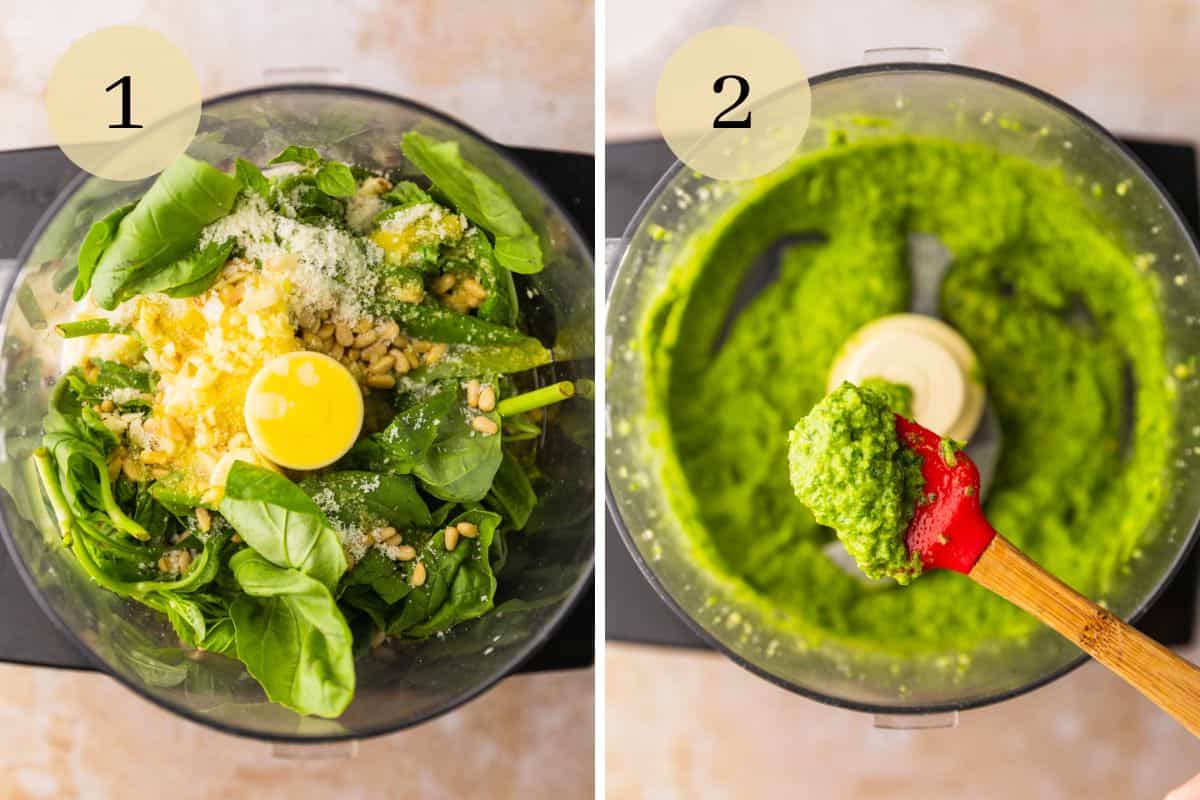
📘 Glossary
If you don't recognize a tool or skill I mentioned, you can look it up in my Glossary of Cooking Terms and Definitions for more information!
📋 Different Types of Pesto
Pesto is great because you can make different flavors by switching out an ingredient or two. Here are some suggestions:
- Nuts - Try walnuts, pistachios, almonds, pecans, or sunflower seeds instead of pine nuts. You can also experiment with combinations of nuts too.
- Greens - Use spinach, kale, or arugula instead or mixed with the basil.
- Spice - Adding freshly ground black pepper or crushed red pepper flakes can add an extra zip to the pesto.
💭 FAQ's About Making Pesto
If your pesto has a bitter flavor, it's most likely due to expired olive oil or pine nuts. When pine nuts or olive oil are past their prime, they are rancid and can taste bitter.
The addition of lemon juice keeps the pesto from browning too quickly. Proper storage will also prevent browning. Use a container that is the exact size of the amount of pesto you have so it fills almost to the top. Drizzle a layer of olive oil on top as well to keep extra air out.
🥡 The Best Way to Store Homemade Pesto
- FRIDGE - Store the pesto in an airtight container so it's almost filled to the top. Drizzle olive oil over the top and keep in the refrigerator for up to 1 week.
- FREEZER - Pesto will last in the freezer for about 6 months. I freeze portions in ice cub trays and then transfer them to a freezer bag to easily pull out what I need.
🌿 Recipes to Use Basil Pesto
Fresh Homemade Basil Pesto can be used in more than just pasta. It's really good on top of grilled meat or fish, on sandwiches, pizza, or salads, or with Crusty Italian Bread. Here are some other recipes to use your freshly made pesto:
📖 Recipe

Italian Basil Pesto (Pesto alla Genovese)
Video
Ingredients
- 2 cups fresh basil , both stems and leaves (packed)
- ⅓ cup pine nuts
- ¼ cup grated parmesan cheese
- ⅓ cup extra virgin olive oil
- 4 cloves garlic
- 1 teaspoon fresh lemon juice
- 1 pinch kosher salt
Instructions
- Add the fresh basil, pine nuts, parmesan cheese, extra virgin olive oil, garlic, lemon juice, and kosher salt to the bowl of a food processor.
- Pulse the ingredients until they are combined, then scrape down the sides and blend for 30 more seconds to combine. (Extra blending time can be used for a smoother pesto)
- Use the pesto immediately or store for use later. See notes below for storage suggestions.
Notes
Substitutions and Variations
- Nuts - Substitute the pine nuts for walnuts, pistachios, almonds, pecans, or sunflower seeds.
- Greens - Substitute basil for spinach, kale, or arugula.
- Spice - Add freshly ground black pepper or crushed red pepper flakes.
Storage Suggestions
- FRIDGE - Store in an airtight container where the pesto is almost to the top. Add a thin layer of olive oil drizzled over the top to help prevent browning. It will keep in the fridge for up to 1 week.
- FREEZER - Freeze portions of pesto in ice cube trays and then transfer to a freezer-safe bag for up to 6 months.


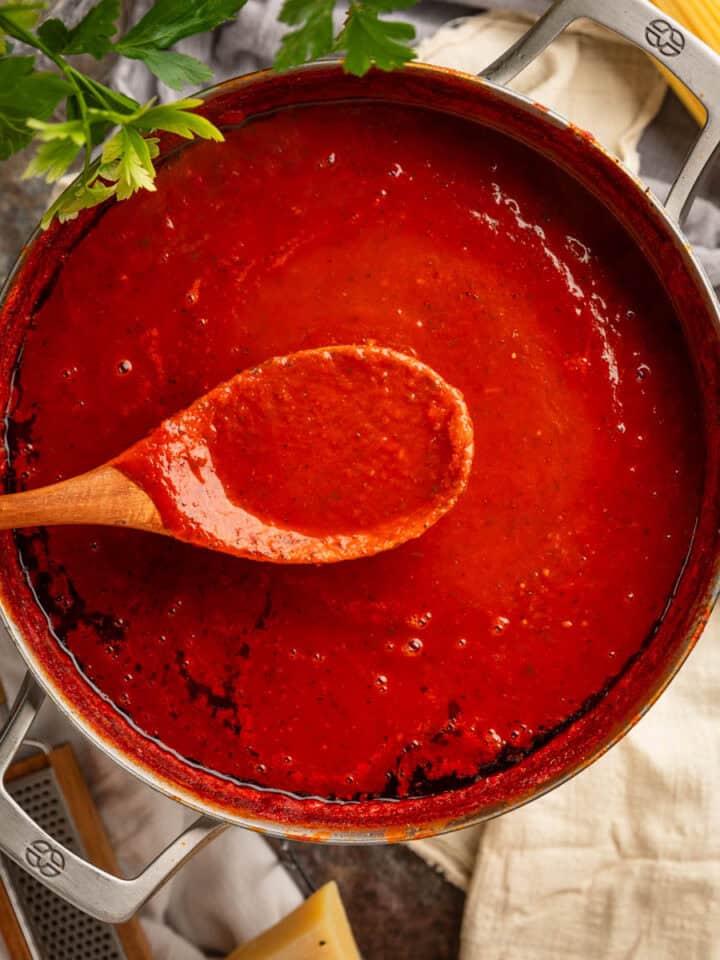
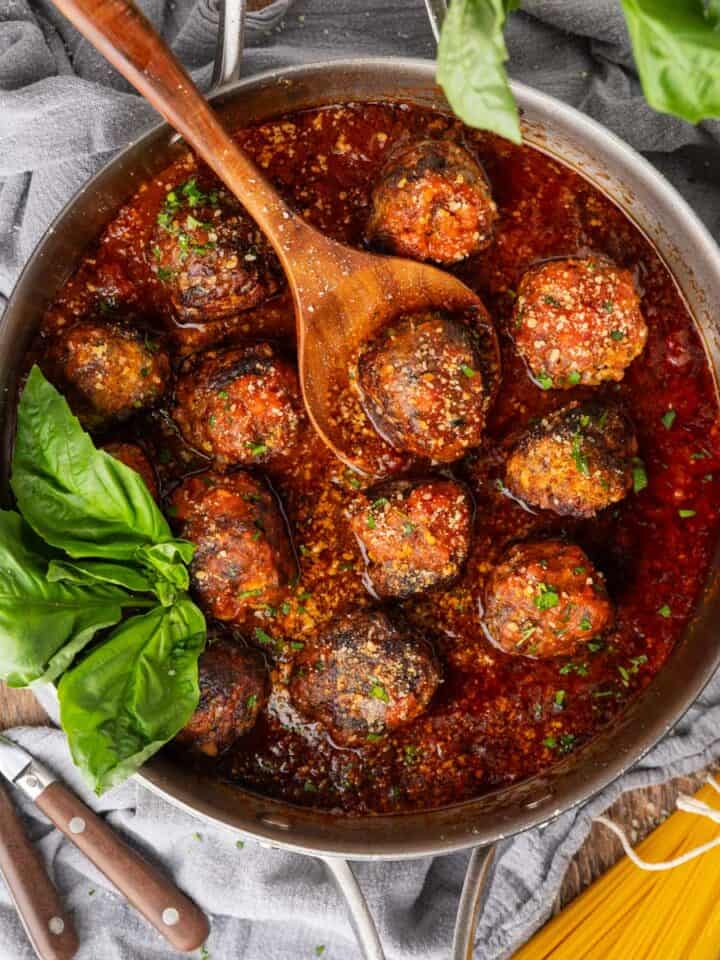
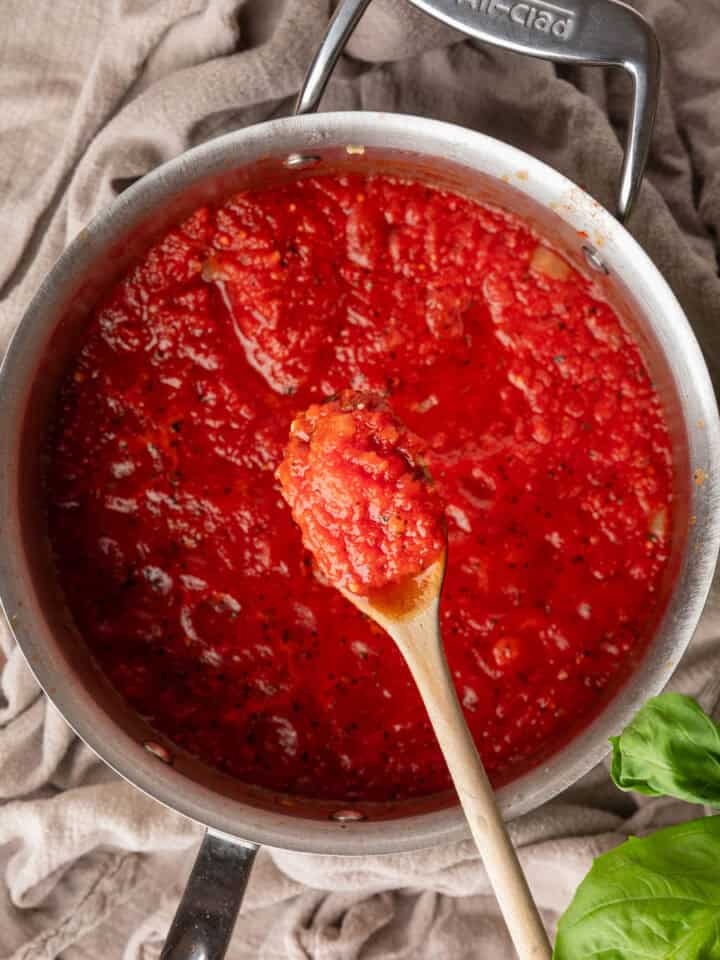
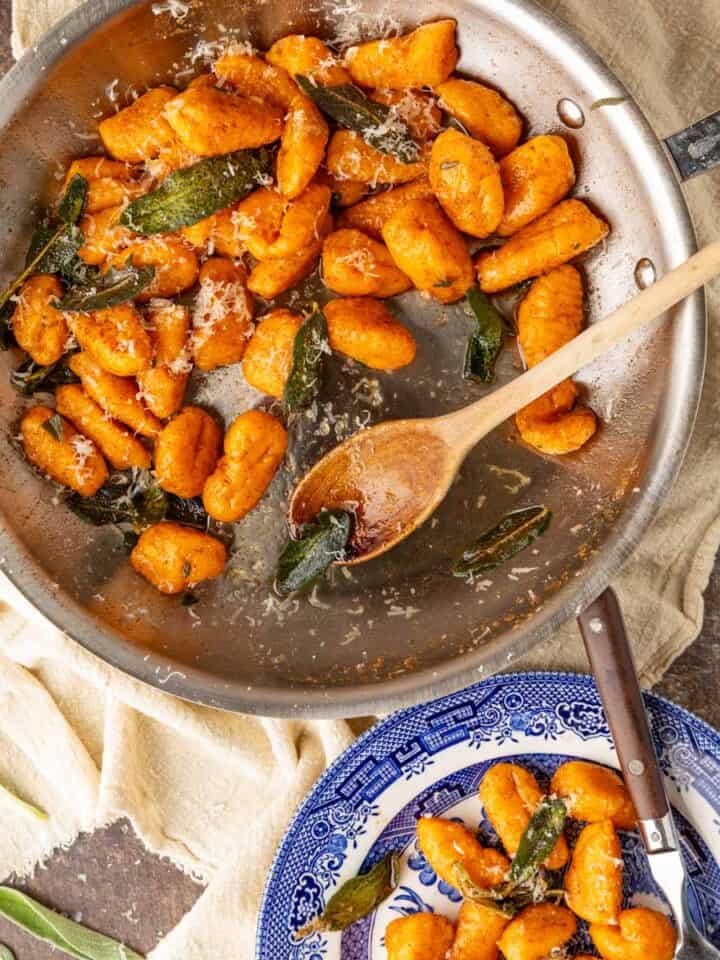
Linda
Perfectly easy and delish!
Amanda Scarlati
Thanks Linda! I'm glad you enjoyed the recipe.
Vickie
Hi! Love this recipe! Have a question before I try it. Following the comments, I see that the stems are bitter and can be left out. Could I counter that instead with a little sugar or honey? If I use just leaves, that throws a lot of leaves in there. I made that mistake with a watermelon basil sorbet recipe. The flavor was very intense. It was good for 4 or 5 bites... and then it wasn't. I don't want to do that to this recipe. Would it be better just to slightly sweeten it or replace half of the basil volume with spinach? Thanks much. First time on your site - recommendation from a friend - and as I scroll down, I see sooo many recipes I want to try.... I'm hooked!
Amanda
Hi Vickie! Thanks for your question. I personally like using the stems because I hate waste and don't find it too be bitter. However, everyone's taste is different. My first inclination would be to try the recipe as written, then mix in a pinch of sugar if it's too bitter for you. Spinach is more mild and would tone down the overall basil flavor as well, so it's up to you. I haven't personally tried a 50/50 mix of spinach and basil but I still think it would be delicious. Can't wait to hear back from you!
Lauren Mouw
How much does 1 recipe make?
Amanda
Hi Lauren! This recipe makes approximately 1 cup of pesto.
Wendy
I thought it was unusual to include the stems. Unfortunately I tried making this recipe including the stems, NOT recommended.
Amanda
Hi Wendy, I'm sorry it didn't turn out the way you expected. It's very common to use both leaves and stems to make sure there is no waste and you get the full flavor of the whole pint. The stems can sometimes be slightly bitter, so if you would prefer, you can definitely only use leaves.